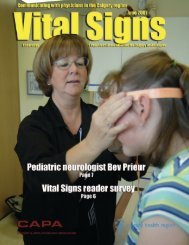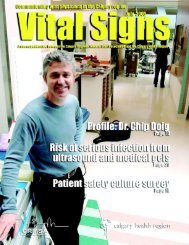May08 VS.indd - Calgary & Area Physician's Association
May08 VS.indd - Calgary & Area Physician's Association
May08 VS.indd - Calgary & Area Physician's Association
You also want an ePaper? Increase the reach of your titles
YUMPU automatically turns print PDFs into web optimized ePapers that Google loves.
Vital Signs May 2008 • Page 6<br />
Member business alliance (MBA) update<br />
JustListed<strong>Calgary</strong> real estate team<br />
The JustListed<strong>Calgary</strong> real estate team is proud to partner with<br />
CAPA and offer its members substantial savings when buying and<br />
selling real estate. You will get all the benefi ts of an award winning<br />
team, extensive marketing plans, and most importantly, proven results<br />
well above the industry average. Savings in the 10-25% per cent range<br />
are being offered to all members who show their membership card.<br />
Please contact Mike Hannah with any questions or to obtain<br />
these substantial discounts.<br />
New collaborative care model planned for the <strong>Calgary</strong> Health Region<br />
By Janice Harvie, CHR communications<br />
Workforce shortages are<br />
wreaking havoc on the health care<br />
system. Some of the most visible<br />
effects are closed beds, dissatisfied patients and burned out,<br />
disillusioned staff.<br />
Aggressive recruitment and retention strategies are being<br />
implemented. In addition to ‘pumping up the volume’ with increased<br />
staff numbers, the <strong>Calgary</strong> Health Region will soon embark on a large<br />
scale system and culture change to deliver care via a collaborative<br />
care model that will ultimately take root in about 80 per cent of<br />
service areas.<br />
Dubbed the ‘workforce optimization initiative,’ the plan is to<br />
reorganize the workforce (where appropriate) to realize greater<br />
effi ciency and effectiveness in health services delivery. The initiative<br />
is fi scally neutral.<br />
“The literature supports this vision and we’ve brought a number<br />
of strategies and projects involving education, data profi ling, clinical<br />
leadership development, regulatory and HR changes and others under<br />
our umbrella to ensure the entire effort is coordinated and builds<br />
on existing good work,” says Dr. Jim Silvius, VP & associate chief<br />
medical offi cer responsible for patient care innovation and health<br />
technology, and a practicing geriatrician at Rockyview General<br />
Hospital. Dr. Silvius co-leads the initiative with Marilyn Visser,<br />
director interprofessional education and workforce utilization.<br />
The groundwork is about evaluating and addressing what’s<br />
preventing the system from working to the greatest benefi t of patients<br />
and providers. One of the key concepts within workforce optimization<br />
is collaborative practice, which represents (and requires) a major shift<br />
in thinking about our approach to patient care.<br />
“Collaborative practice is not just about practicing as a member of<br />
a team. Many of us would already say we are part of a team, but not<br />
many of us would say we work in the most effi cient system, particularly<br />
from the patient’s perspective,” says Silvius.<br />
Collaborative practice is a model in which everyone works to<br />
the full scope of their knowledge, skill and training in a process of<br />
continuous communication and shared decision-making that includes<br />
the patient and family, to achieve outcomes that could not be achieved<br />
by any one person working alone.<br />
What collaborative practice looks like in community care, in acute<br />
care and even for individual units or services is open for discussion.<br />
Because it is customizable to a certain extent in different settings,<br />
physicians are strongly encouraged to provide input when their units<br />
engage in the process and through unit councils.<br />
The implications of a new service model for physicians will be<br />
most evident in how and with whom they interact during the course<br />
of providing care. “We’ll still talk to the person most appropriate for<br />
giving or getting information about our patient, but that person may<br />
not always be the most senior nurse,” says Silvius. “We need to be part<br />
of the design in our areas because the number one principle of this is<br />
to better meet the needs of the patient. This process allows physicians<br />
to be part of developing how this is achieved in their area.”<br />
Admittedly, the collaborative practice model and other optimization<br />
strategies will not solve the region’s workforce issues. But it’s a vital<br />
step in the right direction. “Imagine how improved worklife could be<br />
if our system was functioning better, how much happier people would<br />
be if they were actually doing what they were trained to do and in a<br />
system that wasn’t so stressed,” says Silvius.<br />
The workforce optimization initiative will be piloted in six acute<br />
care units at the Foothills Medical Centre in the coming months with<br />
an enterprise-wide implementation strategy developed by the fall.





